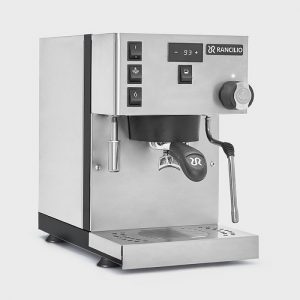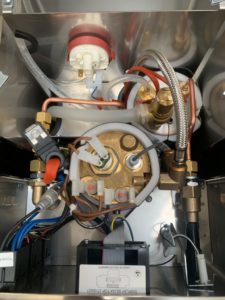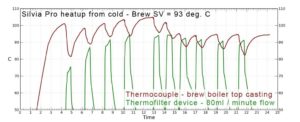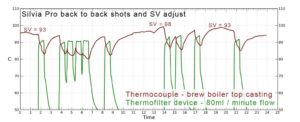 After a long wait, our first Rancilio Silvia Pro has arrived and is on our bench amongst some other great gear.
After a long wait, our first Rancilio Silvia Pro has arrived and is on our bench amongst some other great gear.
We got straight to it, filled it and fired it up.
So….What do you think?
She’s definitely loooong! A buddy who had a look over responded with “Junk in the trunk!”
Out of the box, all was pretty familiar. Ours had been primed by the importer, so it had a quick drink and began heating. The group was plenty hot with 15 minutes of warmup, so it’s looking like it will come to temperature pretty fast.
Looking at the front, nothing much to see here other than the PID display which conveniently acts as a shot timer when in operation. The hot water wand is obviously a new inclusion. All switches other than the power switch are spring loaded in that they activate the function required and then pop back as they were initially.
As it warmed, we watched the PID come to temp and then it got busy heating the steam boiler. The diode over the steam handle switched on permanently and we were ready to shoot.
In the etxMax was a beautiful 5 day old Ethiopia Yirgacheffe Honey process and it became the first shot. A tad tight. A little grind adjustment and we were looking like we were in the zone. One shot each for two players. Freaking good and definitely as good as any other dual boiler PID machine out there. It’s looking positive so far…
We tried a couple of piccolos with milk. Milk texture- good, and quick enough through the ball-jointed wand. The wand has 3 holes and pretty fine bore, so things were ok here. The pressure is lower than your typical Silvia, but it’s also much easier to drive: By no means crazy fast, but no major concerns.
So what of the steam switch? What we found is that when the switch it activated, power to the steam boiler is cut until reactivated. It turns your Silvia Pro into a shot only machine if required.
To this point, there has been some discussion online as to the feed of water to the brew boiler: In general, dual boiler machines feed “pre-warmed” water to the brew boiler via a heat exchanger in the steam boiler. The Silvia doesn’t do this and instead receives cold water from the tank. Is it an issue? We decided on some Scace testing to check what’s happening with shot temps in different scenarios….(see below).
Inside?
 We opened up… It’s like a 60’s Holden with a heap of fresh air and I guess that it could be somewhat dictated by the availability of suitable off the shelf parts/boilers? This machine could easily have been 5cm, perhaps even 10cm shallower with a revised tank and/or boilers? Woulda/coulda? There is a heap of dead space…
We opened up… It’s like a 60’s Holden with a heap of fresh air and I guess that it could be somewhat dictated by the availability of suitable off the shelf parts/boilers? This machine could easily have been 5cm, perhaps even 10cm shallower with a revised tank and/or boilers? Woulda/coulda? There is a heap of dead space…
- The brew boiler could easily move forward
- Plenty of dead space beside the steam boiler and under the visible plumb run from the steam boiler to the hot water solenoid. We think it would have been easily possible to better use the available real estate. The steam boiler could even have been laid down and moved partially under the brew boiler for a far more compact machine. Regardless, this won’t affect usability and the machine won’t be too tricky to work on for routine tasks.
One item flagged is that although the brew element is replaceable, the steam element is integral to the steam boiler and if something goes pop, it’s likely to be the steam element, not the brew element. We have asked the question as to what class of element is being employed here. With the stainless elements used in brew, failure is relatively rare these days. You’d want longevity for the steam element as there would no doubt be “ouch factor” should a steam boiler need to be replaced. Mark a negative for sustainability. If we can find out anything about the steam element, we’ll update here.
With the original Silvia, a cottage boiler rebirth industry existed. You brought your cooked Silvia boiler with dead element to “the guy”. He drilled out and installed a replaceable element which saved you money the next time it died. All changed with the V5 Silvia in that the element was easily replaceable should it die. What will the steam boiler longevity be? Time will tell…
Testing…
- Our basic observations are that heating time from cold is rapid and after 10 minutes of warm up, shot temperature is reliable and repeatable after 3 or 4 shots or backflushes. It’s realistic to allow 10 minutes from cold to thermal stability. Steam was also up to operating pressure within 10 minutes.
- The brew boiler is always prioritised, so during brew recovery after pulling a shot, steam can be quickly depleted, especially if an autofill event were to occur. That stated, the response to steam usage is also quick. Scace device logs are below for those into graphs. The absence of a heat exchanger is no major impediment as the small brew boiler recovers rapidly.
 Other thoughts:
Other thoughts:
Steam? The steam boiler at 1.0 litre is smaller than more expensive, larger form factor competitors. Nevertheless, it’s fine for a couple of regular coffees and the steam recovers pretty quickly for usual family requirements. It’s not made for coffee cart duty but you will be fine for that dinner party.
 Weird: The timer function is crude and is reminiscent of your dishwasher. “How many hours do you want me to wait until I start?”
Weird: The timer function is crude and is reminiscent of your dishwasher. “How many hours do you want me to wait until I start?”
Nice: Inbuilt PID functions to drain brew or steam boiler make for easier descaling if/when required. Regardless, we still recommend that high quality espresso suitable water be used…
In conclusion…
On the whole so far, our first impressions are that it’s pretty good. This bigger, dual boiler version of the little machine that can does the job well and offers good performance at this price point.
If you’d like to learn more, you can download a copy of the Silvia Pro user manual
When can I buy one?